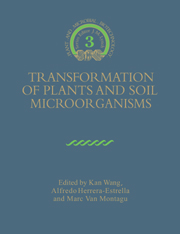Book contents
- Frontmatter
- Contents
- List of Contributors
- Series Preface
- Preface
- Acknowledgements
- Abbreviations and Terms
- Part I Transformation of Soil Microorganisms
- Part II Transformation of Cereal Crops
- Part III Transformation of Industrially Important Crops
- 8 Leguminous Plants
- 9 Spring and Winter Rapeseed Varieties
- 10 Sunflower
- 11 Forest Trees
- Index
10 - Sunflower
Published online by Cambridge University Press: 04 August 2010
- Frontmatter
- Contents
- List of Contributors
- Series Preface
- Preface
- Acknowledgements
- Abbreviations and Terms
- Part I Transformation of Soil Microorganisms
- Part II Transformation of Cereal Crops
- Part III Transformation of Industrially Important Crops
- 8 Leguminous Plants
- 9 Spring and Winter Rapeseed Varieties
- 10 Sunflower
- 11 Forest Trees
- Index
Summary
Introduction
The cultivated sunflower {Helianthus annuus L.) is one of the four most important species grown worldwide as oil crops. Sunflower oil is appreciated for its high nutritional value, due to a balanced content of fatty acids. This position as an important, and in some countries almost exclusive, source of one of the basic food components, has been made possible by a very successful application of conventional breeding techniques. The economic importance of sunflower has recently stimulated interest in biotechnological approaches, which are expected to further extend the possibilities for improvement of this species. A major issue in this context is, of course, the transfer of isolated genes that will confer novel characters on this important crop.
Although first reports of sunflower tissues cultured in vitro date back to the early times of plant tissue culture (e.g. De Ropp, 1946; Hildebrandt, Riker & Duggar, 1946; Henderson, Durrell & Bonner, 1952; Kandler, 1952), serious interest in the in vitro culture of sunflower tissues and cells is quite recent, a situation that is reflected in the comparatively small number of publications dealing with this issue. Moreover, this species has proven quite recalcitrant to regeneration, and technological advances as well as the comprehension of the underlying problems still flow at a slow rate. In the absence of a significant number of publications on transgenic sunflowers, the purpose of this review cannot be a critical discussion of the stability of foreign genes in such plants, nor an evaluation of the methods by which these genes could have been introduced.
- Type
- Chapter
- Information
- Transformation of Plants and Soil Microorganisms , pp. 137 - 149Publisher: Cambridge University PressPrint publication year: 1995
- 1
- Cited by



